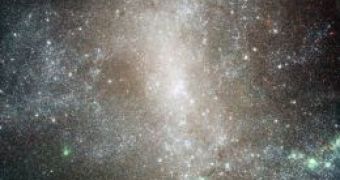Scientists have supposed for long that young or "open" star clusters must eventually disintegrate and dissolve into the host galaxy.
Their gravity is so weak that it just can't keep them together, opposite to the much bigger globular star clusters.
Observing exactly how star clusters disintegrate was tricky from Earth, as they are easily lost in the cluttered star field background of the host galaxy, but Hubble came with critical clues.
A team of the Space Telescope Science Institute in Baltimore investigated this using Hubble, in order to get a close observation of the barred spiral galaxy NGC 1313 and discovered that many very young massive blue (B-type) stars are not connected to compact star clusters anymore.
B stars burn at a speed rate of their hydrogen level, fact that make them very short lived (a few tens of millions of years). The large amount of massive B-type stars points to the fact that star clusters may vanish very rapidly, within 25 million years.
This is a second compared to the galactic time, because the lifetime of a galaxy is measured in billions of years. B stars are much more common in the galaxy than even the more massive O-type, fact that enhances the idea of a rapid end.
The O stars have such a short lifespan (maximum several million years) that they end in supernovae explosions before they can be spread outside the cluster. "In fact, the supernovae explosions of O stars could be the reason for a cluster's rapid disintegration," say researchers.
A supernova explosion can expel out residual dust and gas from star inside a cluster, which provokes a sudden dangerous loss of gravitational mass in an open cluster, which make it prone to disintegration and will be adsorbed easily by other stars.
Hubble images of the Antennae galaxies, a colliding pair of galaxies, revealed that 90 % of the clusters disappear like that during the first 10 million years of their life.
But NGC 1313 proves it for the first time in a normal spiral galaxy.
Extrapolating this to our galaxy, the Milky Way, will help us better understand how the Sun emerged.
Image credit: NASA

 14 DAY TRIAL //
14 DAY TRIAL //